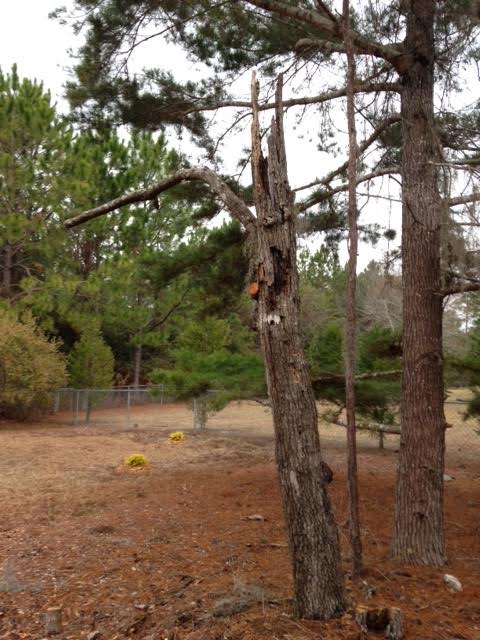
by Julie McConnell | Jan 13, 2015
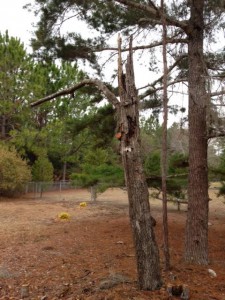
This dead oak tree was trimmed up to make it neater. It is ready for a wildlife resident! Photo: JMcConnell, UF/IFAS
One of the management issues that any landowner will face at some point is what to do when a tree dies in the landscape. The logical response is “cut it down,” but depending on the location and the size of the tree, that may not be necessary and you could be removing potential wildlife habitat.
With any other major decisions about your landscape, always consider safety first. If the tree is in a location where it could damage property or cause harm to people or domesticated animals then it should be properly removed. But what about those trees that are along wood lines or in the far reaches of the yard and not threatening person or property?
Consider leaving the entire tree or modifying it to make it more aesthetically pleasing yet still useful to wildlife. Weak branches or unstable tops may be removed to make the snag less of a risk or to look a little neater.
Some examples of animals that may use dead trees in the landscape are birds, bats, squirrels, frogs, and lizards. Besides the obvious cavity dwelling creatures such as woodpeckers, owls, and bats that are attracted to decaying trees, other animals will be drawn for other reasons. Dead trees in the landscape will become inhabited by insects and fungi which are terrific food sources for birds, mammals, amphibians, and reptiles!
To learn more about providing wildlife habitats in your landscape, please see the EDIS publications listed below or contact your local extension office.
Helping Cavity-nesters in Florida
A Birds-Eye View: How Birds Select Habitat
Dead Wood: Key to Enhancing Wildlife Diversity in Forests
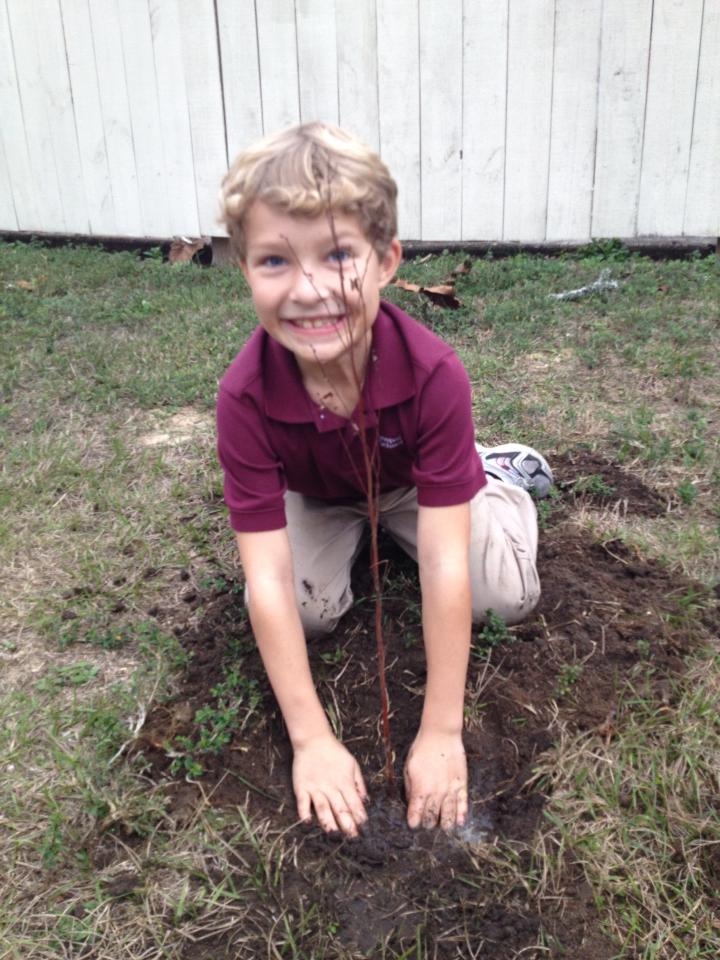
by Carrie Stevenson | Jan 13, 2015
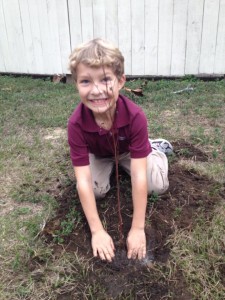
Planting a tree is an excellent way to insure clean air and water in the future. Photo credit: Carrie Stevenson
Most of us begin a new year with resolutions–to exercise more, to eat right, to spend our time more productively–but few things have as many lasting impacts for the future as the simple act of planting a tree.
Arbor Day (which literally means, “Tree Day”) was founded in 1872 by J. Sterling Morton, a naturalist and journalist in Nebraska. By 1882, it was celebrated by thousands of schoolchildren nationwide, who planted trees and took care of them with their classmates. Today, millions of communities and schools celebrate Arbor Day all over the world. Trees provide endless benefits, including shade, recreation, food and building products, shade and wind protection, wildlife habitat, oxygen production and carbon dioxide uptake.
Arbor Day is typically celebrated in the United States on the last Friday of April, but as ideal tree-planting conditions differ by climate, each state has its own specific Arbor Day, as well. Winter is the ideal time to plant trees in Florida, because it allows roots to develop without expending energy on growing new leaves and shoots. Our state celebration this year is January 16th.
Many local communities in Florida hold special events around this time. Be sure to check with your local Extension office or Native Plant Society chapter to find out if they are offering free trees or public events this month. For more information on the best trees for your area, be sure to take the time to read “Native Trees for North Florida” or peruse the UF Environmental Horticulture web page.

by Mary Salinas | Dec 16, 2014
This is the time of year when leaves are turning shades of yellow and red and falling from the trees. And this spurs homeowners to get out there with their rakes and rid them from their lawns. This is a good practice as too many leaves will shade out the grass and decrease the quality of the lawn come next spring. So, go ahead and rake them up. However, think about using as many as you can as mulch in other parts of your yard.
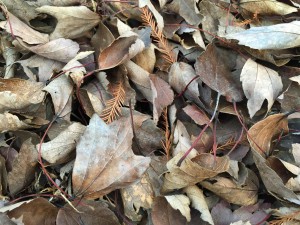
Leaves as mulch. Photo credit: Mary Derrick UF/IFAS Extension.
Leaves can be placed as mulch in landscape beds “as is” or chopped up with your mower or shredder into finer pieces and then spread around perennials, shrubs and trees. When chopped up or shredded, they tend to stay in place much better and don’t blow around when it gets windy. As the leaves break down over time, their nutrients are released and become available; that’s free fertilizer for your landscape plants. Leaves as mulch do have a natural look in the landscape, so if you prefer a more formal or polished look, you can spread a thin one-inch layer of a commercial mulch over the leaves.
Organic mulches (those made from plants) offer many benefits. They add organic matter and improve soil fertility as they decompose, thus reducing the need for added fertilizers. Mulch helps to maintain soil moisture so less frequent irrigation may be needed. Soil-borne disease can also be prevented as the soil does not splash up on the bottom leaves of plants during periods of rain. One of the favored reasons to use mulch is to prevent weeds in your landscape beds. And, of course, mulch is much prettier to look at than bare ground!
So how deep should you apply mulch? University of Florida experts advise a 3 to 4 inch layer of mulch around shrubs and trees. However, keep mulch from setting against the stems and trunks as that can cause moisture and pests to adversely affect them. Place just a thin one-inch layer of mulch over the rootballs of your plants.
Using leaves as mulch recycles a natural resource and saves you money, enriches your soil, fertilizes your plants and keeps them out of the local landfill.
For more information:
Landscape Mulches: What Are The Choices in Florida?
Mulch Recommendations

by Larry Williams | Dec 9, 2014
From about mid November or December to March, deciduous trees have little to no foliage making us more aware of their shapes, forms and barks.
Here are a few trees to consider for adding winter appeal to your landscape.
Gary Knox, UF/IFAS Horticulturist, describes the crapemyrtle’s winter interest perfectly in his publication, “Crapemyrtle in Florida.” Knox writes, “When the leaves fall in winter, the crape myrtle becomes a living sculpture. The trunk and branches of tree-form plants have an attractively gnarled, sinuous character with smooth bark. Strips of bark peel off (exfoliate) in early summer to reveal mottled new bark ranging in color from pale cream to dark cinnamon to rich brown to bright orange.”
Here are some recommendations for crapemyrtles with attractive bark. ‘Acoma’ is an outstanding semi-dwarf hybrid reaching a mature height of 10 to 15 feet that has creamy beige bark and snow white flowers. ‘Apalachee’ is another outstanding selection with cinnamon orange bark and light lavender flowers. Its mature height is about 20 feet. The cultivar ‘Osage’ produces dark orange bark and medium pink flowers with a 20-foot mature height. ‘Fantasy’ is a large maturing variety growing to more than 20 feet tall with outstanding red orange bark and white flowers. More cultivars are listed in Knox’s publication available at http://edis.ifas.ufl.edu/MG266.
River birch is another tree with unusual papery peeling bark. The cultivar ‘Heritage’ is the closest to a paper white birch that will tolerate our hot summers. Expect a river birch to reach 40 to 50 feet in height and 25 to 35 feet in width.
Cultivars of Ulmus parvifo
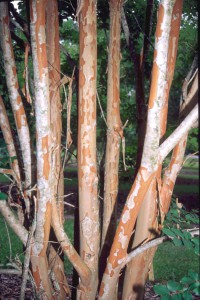
Apalachee Crapemyrtle Bark Photo Credit: UF/IFAS
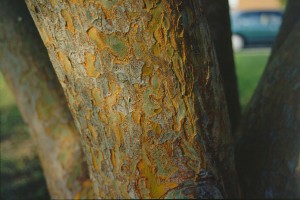
Drake Elm Bark Photo Credit: UF/IFAS
lia, Chinese elm, provide winter interest. “The showy, exfoliating bark reveals random mottled patterns of gray, green, orange and brown, adding great textural and visual interest, especially to its winter silhouette,” writes Ed Gilman, UF/IFAS Horticulturist, in his factsheet on Chinese Elm. This and other tree factsheets are available at http://hort.ifas.ufl.edu/woody. ‘Drake’ and ‘Allee’ are two popular Chinese elm cultivars. Chinese Elm can reach 80 feet in height but is more often seen at 40 to 50 feet with an equal spread.
American Hophornbeam, Ostrya virginiana, is an underused tree that grows to about 50 feet in height. Its grayish bark peels off in longitudinal strips revealing orange patches underneath.
Acer buergeranum or trident maple is a small, underused and hard to find tree. It usually is seen with multiple stems originating fairly low on the trunk giving the small tree a bushy appearance. It has noticeable orange-brown peeling bark.
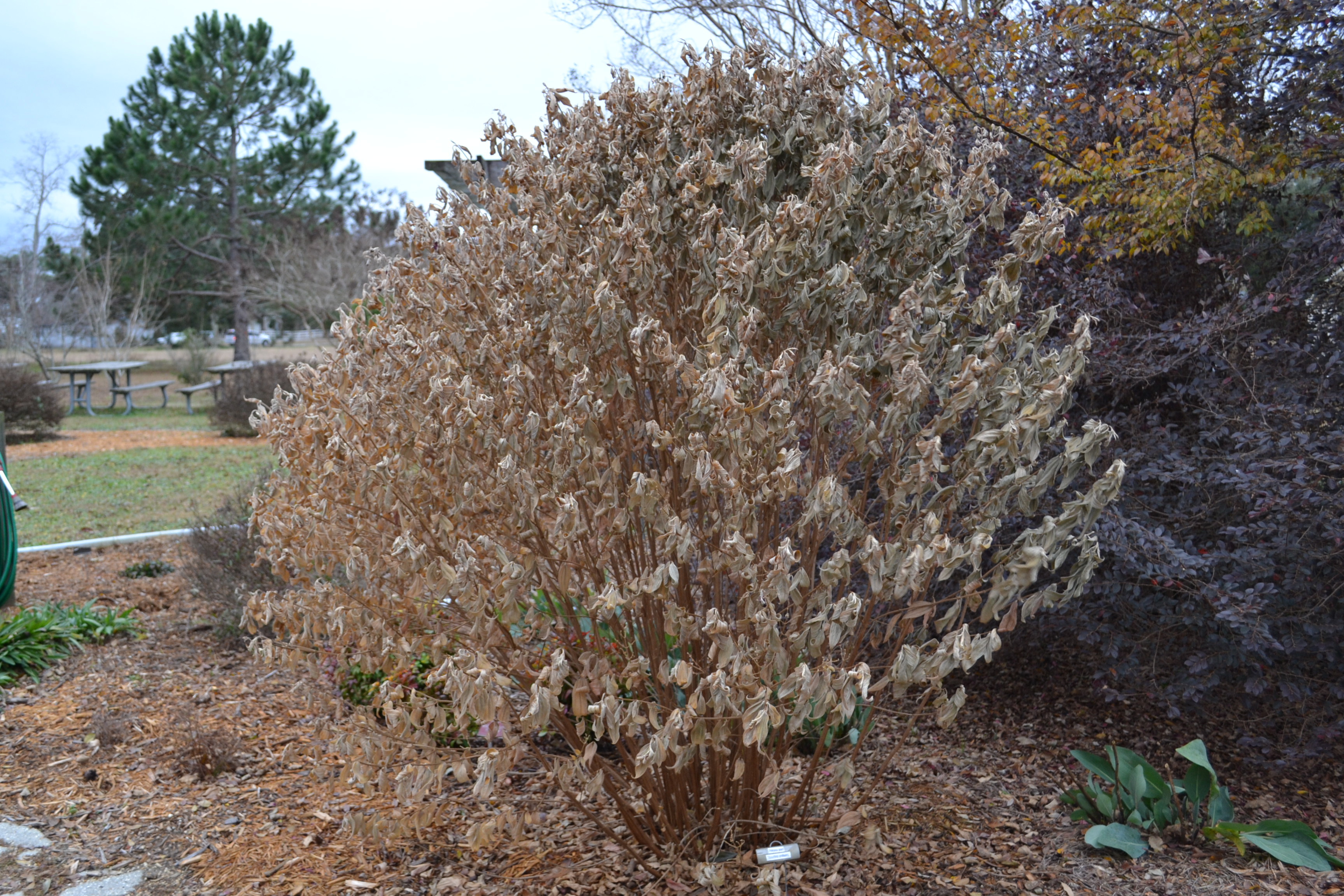
by Beth Bolles | Dec 2, 2014
Our recent cold weather was not only a surprise for many locals but also for many plants that still had plenty of green growth. After a couple of nights of freezing temperatures, even deciduous trees that had not dropped their leaves, look a little ratty.
Since it is just the beginning of December and we are likely to have many more days this winter with cold weather, now is not the time to react to plants that were damaged. There are a few exceptions of plants that you can prune back, but in general patience is the key for the winter garden and cold-damaged plants.
Here are a few guidelines.
Unless planted in very protected spots, annuals like coleus and angelonia were killed by recent cold air. You may remove these plants or cut them back close to the group to make garden areas look neater. You may want to add some new winter annuals to brighten up these spots.
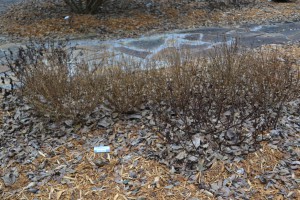
Warm season annuals can be removed from the garden.
Both young and mature citrus trees experienced injury since many plants still had tender growth. Do not prune out any damage at this time. We will wait until next Spring to learn where the growth will resume and then prune as necessary to remove dead branches.
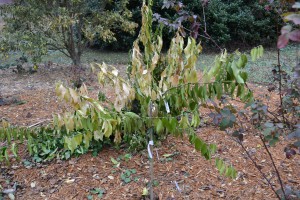
The tender growth on a young Meyer lemon was damaged by cold air.
As expected, the above ground portions of flowering perennials were severely injured by cold air. It is best not to prune these back now since the layer of branches and foliage may help insulate lower branches that could still have some life. If you are not able to tolerate the look of cold-damaged perennials in your garden, consider only pruning half of the plant just to make a neater appearance in the garden. When warm weather returns next year, we may be surprised to see growth resume on lower stems.
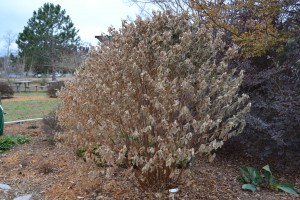
Many flowering perennials like Tibouchina will return from the ground next year.
Deciduous trees that would have normally dropped leaves before the cold have full canopies of dead leaves. Trees will eventually drop these leaves aided by winter winds and rainfall.

This Japanese maple will eventually drop it’s cold-damaged leaves and offer attractive bark and structure in the winter garden.

by Carrie Stevenson | Nov 25, 2014
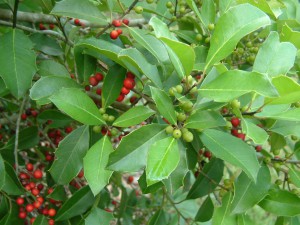
The Savannah holly has beautiful leaves and berries throughout the winter. Photo credit: Carrie Stevenson
As the holiday season comes upon us, many folks will be spending their weekends scouring tree farms and mall parking lots for the perfect Christmas tree. There are many very realistic-looking options for artificial trees these days, and they are a great way for families to reduce waste by reusing the same tree year after year. However, a live Christmas tree brings greenery inside, smells wonderful, and provides a central focus for many of our holiday traditions. Many cut trees will last over a month with good watering, but when the holidays are over, what do you do with your tree?
Many cities and counties offer a Christmas tree recycling program, in which trees can be left at drop-off sites or on the curb for pickup. Most municipalities turn the trees into mulch and use it at public facilities. Many individuals reuse trees by placing them in lakes or other water bodies as fish habitats, creating reefs for hiding and nesting. However, be sure and check with local environmental agencies before placing trees under water. If you own a good bit of land or a wooded area, you can lay your old tree out for small mammals and birds to use as shelter. It will eventually biodegrade and add nutrients to the soil. Be sure that if you take advantage of any of these recycling options that you remove all ornaments, tinsel, or other decorations which could be hazardous to animals and/or wood-chipping machines.
There is an option to truly keep your tree evergreen—a live Christmas tree! Many retailers sell potted trees that can be brought inside and decorated, then planted outside after the season is over. One of the plants often associated with this festive time of year is holly, which is an excellent choice for evergreen color throughout the year. There are many native varieties, such as yaupon holly for drier areas and myrtle-leaved holly for wetlands. Hollies are typically used as shrubs in the landscape, although many species can grow into small trees if allowed; the East Palatka holly can be as tall as 45 feet at maturity! Hollies are also an excellent food choice for attracting birds, and the shrubs work wonderfully as a natural screen. While their branches aren’t quite as sturdy as some of the northern varieties, native Atlantic white or Eastern red cedar–or even some local pines–are also excellent evergreen species that can be used.
A live tree or one planted and decorated outdoors is a wonderful way to commemorate a special Christmas and help provide wildlife habitat year-round.
















